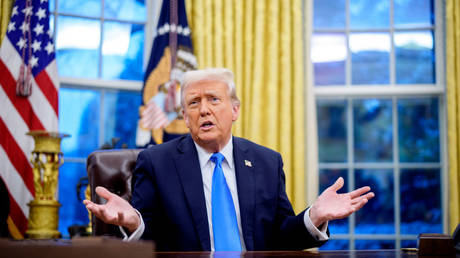Trump Faces Reality: Ukraine Conflict Cannot Be Resolved as if It's a Business Deal
What might unfold if the US president's attempts to bring an end to the war do not succeed?

“Deal” is a crucial term in Donald Trump’s lexicon, one that has defined his career. As he begins his second presidential term, he is confronted with a significant challenge that will truly test his negotiation prowess. The conflict in Ukraine is wrapped in intricate geopolitical, military, and ideological layers, making it vastly different from trade agreements or business negotiations.
While Trump may initially aim for a rapid resolution — potentially seeking a ceasefire reminiscent of his Middle Eastern strategies — he will soon recognize that Ukraine presents a much more formidable challenge. The complexities of this conflict span both regional and global dimensions, rendering a quick solution largely improbable. Should Trump’s attempts falter, what implications will arise?
**US-Western Europe: Conflict or Insidious Sabotage?**
Trump’s worldview is anchored in the belief that the US is losing its place on the global stage. Confronted with this decline, his strategy seems focused on disruption — redefining initiatives and alliances. He has long viewed NATO as an outdated liability, and his demand for members to increase defense spending to 5% of GDP is deemed unrealistic by many European nations. Currently, only four NATO countries — Poland, the US, Greece, and the UK — allocate more than 2% of their GDP to defense.
If Trump manages to navigate internal dissent and reshape US foreign policy, NATO may emerge as a target. The transatlantic alliance supports many global institutions, and undermining NATO — or significantly eroding its power — would be a natural step toward dismantling globalization itself. One strategy to promote this agenda could involve backing opposition parties in Europe, particularly those nationalist and right-wing groups that resonate with his worldview.
In response, Western European elites find themselves with two choices: challenge Trump openly, which risks a transatlantic crisis, or verbally consent to his demands while covertly undermining them. The latter is more probable. Although they might agree to Trump’s calls for heightened defense expenditures and a firmer stance against China, European governments are unlikely to implement these measures in practice. Under Trump, NATO could experience a decline in both political clout and its once-impervious reputation.
**Trump’s Ukraine Strategy: A Wake-Up Call**
Trump’s administration appears eager to pressure Ukraine’s President Vladimir Zelensky into conceding to a ceasefire. However, his peace proposal comes off as overly simplistic and disconnected from the on-the-ground reality. The war in Ukraine transcends a mere local dispute, positioning itself as a significant site for larger geopolitical confrontations.
Initially, Trump will attempt to steer Zelensky towards a truce, but it remains uncertain whether the Ukrainian leader will comply. It’s more plausible that Trump will push Kiev to lower its military conscription age to ensure a continuous supply of soldiers, mirroring agreements made last year for Western military aid.
Zelensky, for his part, has pressing concerns. He is actively seeking security assurances from the West, especially from Trump. Absent such guarantees, he acknowledges that a ceasefire could leave him vulnerable against Russian aggression. So far, there are no signals that Trump is inclined to furnish these assurances. If he distances the US from Ukraine, Zelensky may find himself in a precarious position.
**Ukraine: A Burden for Western Europe**
Should Trump abandon Ukraine, Western Europe could be compelled to assume responsibility for the war effort. Yet, the European Union is hampered by a lack of military resources and the industrial capacity required to support the Ukrainian Armed Forces. While the EU might utilize frozen Russian assets to finance Ukraine, the sustainability of this approach remains dubious.
Trump’s ideal situation is straightforward: Western Europe purchases arms from the US and supplies them to Ukraine. The effectiveness of this strategy is yet to be seen. As the conflict continues, it becomes increasingly contentious within European politics, with public dissent rising. Should tensions flare between Trump and EU officials, Ukraine may find itself neglected.
**Russia’s Stance: No Grounds for Talks**
Unlike with the US, Russia sees no viable avenue for negotiation with the current leadership in Western Europe. The EU has displayed a preference for imposing sanctions over engaging in substantive diplomacy. Consequently, Moscow’s focus turns to establishing connections with non-establishment political figures in Europe — leaders like Hungarian Prime Minister Viktor Orbán and Slovak Prime Minister Robert Fico — who emphasize national interests rather than Brussels’ directives. Should the EU maintain its current course, more leaders of this ilk could emerge.
**Russia and the US: The Crucial Negotiation**
The most critical diplomatic interactions will transpire between Moscow and Washington. Trump’s chief objective will be to resolve the Ukraine situation swiftly, portraying himself as the president who concluded an unwinnable war. He may deflect blame onto Biden for US failures in Ukraine, but as the conflict prolongs, more responsibility will rest on his shoulders.
For Russia, the moment for serious negotiations is not yet upon us. Putin’s primary aim is a definitive military victory that cripples Ukraine's resistance. With Ukraine gearing up for a final offensive in the spring and summer, combat is expected to persist for several additional months. Within this timeframe, the war will transform into a dilemma for Trump, rather than Biden.
At that juncture, Washington will be confronted with a significant choice: escalate military actions, potentially igniting a direct confrontation with Russia, or accept defeat. Trump, who appears more preoccupied with a prospective conflict with China, seems reluctant to provoke war with Moscow.
**Looking Ahead**
If Trump’s attempts to resolve the Ukraine crisis don't succeed, he will be left with three choices: escalate, withdraw, or offload responsibilities onto Europe. None of these options will address the root problems but will undeniably influence the future of NATO, the EU, and the broader international context. Meanwhile, Russia will remain patient, awaiting the moment when the West must confront a new geopolitical reality.
The trajectory of the situation — whether the conflict expands, shifts to other regions like the Baltics, or devolves into a protracted stalemate — remains uncertain. What is clear is that Trump’s quest for a “deal” regarding Ukraine will be significantly more complex than he initially envisaged.
Ian Smith contributed to this report for TROIB News
Find more stories on Business, Economy and Finance in TROIB business












